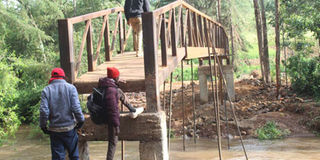Bomet's Kirwa brick footbridge vandalised

Sotik residents crossing Kirwa bridge in Sotik, Bomet County after unknown people removed the bricks which were used to build the it on June,6, 2019. PHOTO | PHOTO | VITAVIS KIMUTAI | NATION MEDIA GROUP
What you need to know:
- The Kirwa bridge in Chemakel had been condemned by the National Construction Authority two months ago.
Geomet Company Limited won the tender to construct the bridge whose works commenced on February, 5, 2019.
- Area residents questioned the safety of the bridge after it emerged that its pillars were constructed using bricks.
The Sh2.4 million controversial foot bridge in Bomet County that was partly constructed using bricks was partly destroyed by unknown people on Thursday.
The Kirwa bridge in Chemakel Ward had been condemned by the National Construction Authority (NCA) two months ago.
The NCA condemned the bridge after area residents protested and demanded an audit on its safety.
TENDER
Geomet Company Limited, which won the tender to construct the bridge whose works commenced on February, 5, 2019,was expected to complete its work on May 4, 2019.
Bomet County Executive in charge of Roads and Public Works Philip Sowek said: “The bridge was brought down by unknown people on Thursday and the matter is under investigation.”
Mr Sowek said the county had appealed against the NCA’s decision to condemn the footbridge.
He said the bridge which connects Kibori and Kipkewa villages in Chemagel Ward in Sotik sub-county was structurally sound and safe for use by pedestrians.
“As a matter of record, the requirements and standards were adhered to in its construction. The contractor implemented the works as required under the supervision of engineers from the county government,” said Mr Sowek.
SAFETY
Engineer Victor Ngetich, the chief officer in the roads department had earlier denied claims that Sh6.4 million was used to construct the foot bridge.
“The Sh2,464,652 million Kirwa foot bridge measures 18 metres long and 1.5 metres wide. It is made of steel standing on reinforced concrete abutment. Stepped up gabions will be constructed on either side to strengthen the structure,” said Mr Ngetich.
A spot check at the bridge showed that the only remaining structures at the site were metal bars standing on concrete slab on both banks of the river and metal bars in the middle.
“It is risky for pedestrians to use the incomplete bridge and residents have reverted to using an old one,” said Ms Catherine Chebet, a resident.





